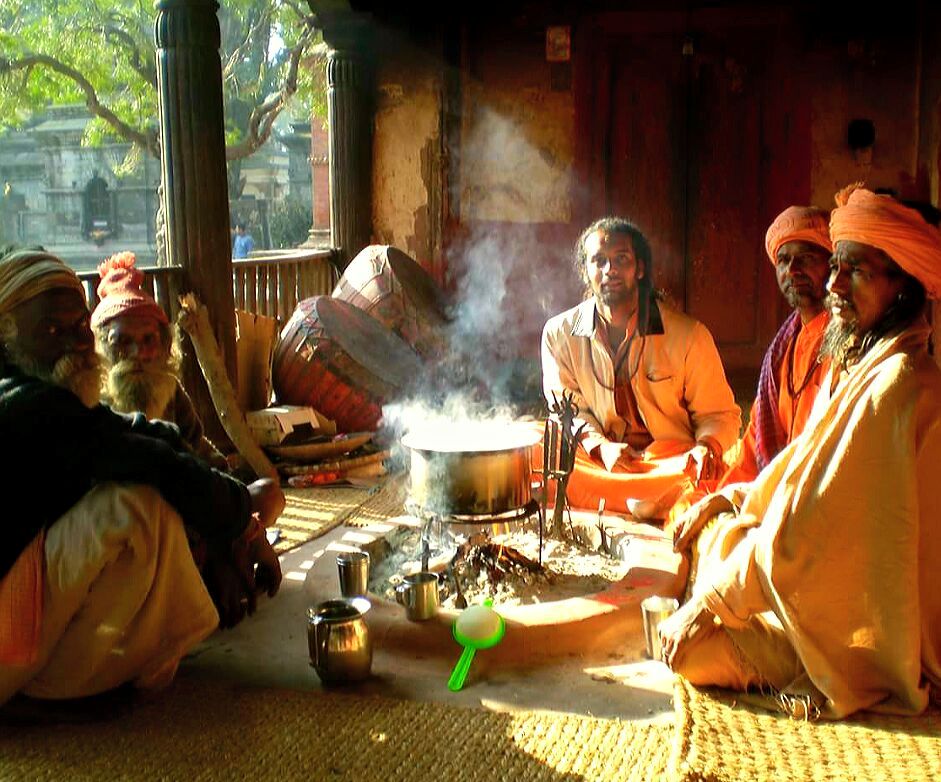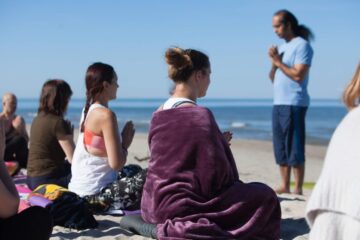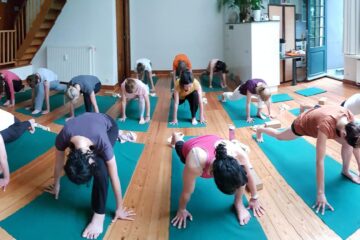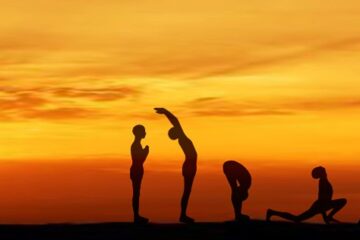Modern, global forms of Yoga exist in a variety of complex recursive relationships with ‘traditional’ Yoga, says the contemporary Yoga scholar James Mallinson. On similar lines, one of the explanations of ‘Yoga’ given by the famous Webster’s dictionary is “a system of physical postures, breathing techniques, and sometimes meditation derived from Yoga but often practiced independently especially in Western cultures to promote physical and emotional well-being.” The connotations of Yoga as a philosophy and practice have been changing since the Upanishadic times. But, over last 100 years or so, Yoga has been interpreted in a variety ways necessitating a new field of study to dissect the origin and nature of what academicians term as ‘modern yoga’. This essay traces the relation between modern Yoga and premodern Hatha Yoga.
According to Andrea Jain, a research scholar of religion, “Modern yoga refers to a variety of systems that developed as early as the 19th century as a [response to] capitalist production, colonial and industrial endeavors, global developments in areas ranging from metaphysics to fitness, and modern ideas and values.” She also says that in contemporary culture, modern yoga is prescribed as a part of self-development and is believed to provide “increased beauty, strength, and flexibility as well as decreased stress”. Andrea Jain credits Elizabeth de Michelis with coining the monograph ‘Modern Yoga’ which she defines as “those disciplines and schools which are, to a greater or lesser extent, rooted in South Asian cultural contexts, and which more specifically draw inspiration from certain philosophies, teachings and practices of Hinduism.” In 2004 Elizabeth Michelis defined a “typology of Modern Yoga” as seen in the West starting from Swami Vivekananda’s 1896 Raja Yoga, with four subtypes, namely: Modern Psychosomatic Yoga, Modern Denominational Yoga, Modern Postural Yoga and Modern Meditational Yoga. According to Mark Singleton, a scholar of Yoga history, “modern, English-language yoga is greatly informed by the textual vision of Orientalist and anglo-Indian scholarship of the late nineteenth century[1]” Now, let’s understand what Hatha Yoga is.
The standard, go-to source of popular Yoga culture, Yoga Journal magazine, says, “Most forms of yoga in the West can be classified as Hatha Yoga. Hatha simply refers to the practice of physical yoga postures, meaning your Ashtanga, vinyasa, Iyengar and Power Yoga classes are all Hatha Yoga.[2]” This reductionist definition equates Yoga to Asana and Asana to Hatha Yoga which does not give a complete picture of Hatha Yoga. Usually, Hatha Yoga is understood as a set of techniques but it goes deeper than that. In pre-modern and classical Yogic systems ‘Hatha Yoga or Hatha Marga’, the path of Hatha Yoga, is understood as an orientation of Yoga that works with subtle physiology for specific teleology, Moksha – liberation from conditional living. The main purview of Hatha Yoga is Prana and mind (Chitta) and the main objective is to release the mind from a vast web of limited tendencies[3]. The path of Hatha is a step to Raja Yoga, where Raja Yoga is defined as Samadhi and Samadhi denotes dissolution of mind and Atman[4]. Along with Hatha Pradipika, Shiva Samhita too states that Hatha and Raja Yoga won’t be successful without each other[5]. These two are some of the primary Hatha texts referred to in modern Yoga and demonstrate a trajectory of process starting with gross modalities and ending with realization of self.
According to scholar James Mallinson, “…for about the past one hundred and fifty years Yoga has been developing in new and important ways, inside and outside India, in response to the process of globalisation and modernisation. Traditional Indian forms of Yoga practice – in particular hathayoga – have undergone sometimes radical transformations and adaptations in the encounter with foreign ideas and practices, and ‘diasporic’ yogas have taken on a life of their own in many parts of the world[6].”According to Mark Singleton, the transnational Anglophone yoga is not “the outcome of a direct and unbroken lineage of hatha yoga“, but it would be “going too far to say that modern postural yoga has no relationship to asana practice within the Indian tradition.” The contemporary yoga practice is the result of “radical innovation and experimentation” of its Indian heritage[7]. As the quotes from both scholars suggest, modern yoga is not a pure product of traditional Hatha Yoga system but a hybrid that organically evolved on its own. But we can’t deny the fact that modern Yoga does have some roots, if not inspiration, in pre-modern Hatha Yoga. Let us try to trace that link.
The age that we understand as pre-modern Yogic period was a time with an extensive and unusual amount of cross cultural encounters between Islamic Sufism, Hatha Yogis mainly of Natha sampradaya, Buddhists, Jains and a number of colonial influences. In this period, Hatha yoga was essentially an esoteric oral tradition because of which it becomes difficult to chart the development of Hatha yoga’s vast history on textual basis as opposed to, say, the traditions of Bhakti or the Advaita Vedantins. From 15th century onwards we see a rise in Hatha Yoga literature coming into the main stream. Hatha Pradipika was compiled by Svatmarama in the 1450s which became the template for many Hatha Yogic authors in the later period between 16th-19th centuries. This period has been called as the ‘classical Hatha yoga’ period by James Mallinson. The period after the classical Hatha Yoga period could be understood as the pre-modern Hatha Yoga period where numerous texts on Yoga proliferated through various ascetic orders like the Dashanami, Ramanand, Nathas and so on. Two popular texts referred to usually in Modern Postural Yoga, namely Shiva Samhita and Gheranda Samhita emerged in the pre-modern period of Hatha Yoga, anytime between 17th and 18th century. Gradually, from the classical Hatha period into the pre-modern Hatha period one notices a rise of interest in Asana. 17th century Hatharatnavali and 18th century Gheranda Samhita and Jogapradipika teach between 32 to 84 Asanas, though not all have been described. They also describe other aspects of Hatha Yoga that have become an integral aspect of Modern Postural Yoga, including Pranayama, Mudra and Bandha. The growing interest in Asana and allied modalities like Mudras was evident from the fact that an illustrated manuscripts based on the Jogapradipika was created in 1830s. In Jogapradipika, description of 84 Asanas occupies 314 out of 964 verses. Many Asanas mentioned in Jogapradipika like the Mayurasana, Viparita karani, Paschimottanasana have become an essential aspect of a modern Yoga asana class culture.
Hatharatnavali, a 17th century text by Shrinivasa lists 84 Asanas along with Kumbhaka, and Bandhas. Even though 84 asana have been listed only 36 have been described[8]. These include a few that are similar to those practiced in modern times like Padmasana, Mayurasana, Gomukhasana, Matsyendrasana, Kurmasana and Mandukasana. Please note, just because the names are similar to those that we practice in modern times doesn’t mean the way they are executed is the same. The execution and nomenclature of Hatha asana is varied across scriptures depending on the lineage and geography of their origin. Another important Hatha text that could have influenced the modern postural Yoga is the early 19th century text Hathabhashyapaddhati. This text describes 112 asana, many of which are not found in earlier texts. One can also find the text describing sequences in asana practice. These sequences have been advised as preparatory practices for Shatkarma, cleansing modalities. Many postures are inspired by animal movements and some have been described to use rope like props. Hathabhashyapaddhati may have been the source for another pre-modern scripture called Shritattvanidhi which illustrates 122 Asana and is attributed to Maharaja of Mysore. Modern scholars think that this scripture could have influenced Krishnamacharya’s choice of Asana and method of execution which became an inspiration for Patthabhi Joise, B.K.S Iyengar, Deshikachar and others from the Krishnamacharya faction. Another scripture from eighteenth century is the Hatha Sanketa Chandrika by Sundaredeva from Varanasi who was known to be an Ayurvedic physician. This scripture talks in detail about cleansing techniques, especially Shankhaprakshalana which could have influenced the practices of Bihar School of Yoga who teach Shankhaprakshalana as a cleansing method in their curricula. The Pranayamas described in this text are similar to those in Bahr-al-hayat, a 16th century text by the Sufi Muhammed Ghawath. One method of Shankhaprakshalana was taught by a popular Yoga teacher from India by the name Dhirendra Brahmachari in the 1960s. Apart from being the teacher to India’s ex-prime minister Mrs. Indira Gandhi, he was also a teacher to Yogi Bhajan, the founder of Kundalini Yoga brand[9].
Another influence of pre-modern Hatha Yoga can be seen on two of the most prominent influencers of modern Yoga, namely, Shri Yogendra, the founder of The Yoga Institute and Kuvalayananda, the founder of The Kaivalyadham Institute. They both studied Hatha Yoga asana and allied modalities from their Guru Paramahansa Madhavdasji. Yogendra defined Yoga as ‘a comprehensive practical system of self-culture’. On the other hand, Kuvalayananda looked at Yoga as a method of therapy and aimed at proving the benefits of Yogic modalities scientifically. These two prominent personalities influenced the infancy of modern (postural) Yoga in the 1920s, 30s and 40s, so much so that between them they had popularized Yoga in the upper sections, intelligentsia and influential circles of India which included Mahatma Gandhi who was a student of Kuvalayananda. The scholar Elliott Goldberg[10] states that before 1900s there were many Sants, Swamis and Sannyasis that did Hatha practices and used their powers and knowledge to heal. But these healing systems were not really taught en masse. It was regarded as mystical, arcane and secret. This attitude changed by 1920s when Asana were started to be practiced independently and publically in Vyayamashala (wrestling schools), stripped from their initiatory tradition. The 20th century Yogis prescribed Hatha yoga as method of healing, relaxation, wellness and rest. Along with the wave of scientific experiments, the modern Yogis claimed that Yoga asanas cured ailments and diseases. Both, S. Sundaram in his book called Yogic physical culture or the secret of happiness (1929), which is known to be the first modern Hatha Yoga manual, and B.K.S Iyengar in his Light on Yoga (1966) state the benefits of asana on the basis of researches and writings of Kuvalayananda. Order of posturing was first formulated by Kuvalayananda in 1925. The full course consisted of 11 asanas, one bandha, one mudra, two kriyas and two pranayama and was presented in October 1925 issue of his magazine Yoga Mimansa. To Kuvalayananda’s 11 poses, Sundaram added two more. Sundaram’s book established a format for Hatha Yoga manuals including formatting of name, technique, benefits, contraindications, photos etc. This format was a model for Iyengar’s Light on Yoga and Sivananda’s ‘Yogic home exercises’ (1938) book, both pioneering books. Krishnamacharya had visited Kuvalayananda on insistence of Mysore Maharaja in 1934 to learn about scientific research on Yoga modalities. Another influential women Yoga teacher, Indra Devi too was a student of Kuvalayananda from 1936-1937. In this way, we can see criss-cross of influences and inspirations between different pioneers of Modern Yoga movement, especially Modern Postural Yoga movement.
The most influential individual to directly or indirectly inspire all the above pioneers was Swami Vivekananda. He studied Hatha Yoga from Pavhari Baba in 1890 for 3 ½ months, 4 ½ years after his Guru, Swami Ramakrishna’s death. He embraced Hatha Yoga as a method of cultivating conditioned body and calm mind through asana and pranayama for meditative practices. After gaining popularity for his speech at the first World’s Parliament of Religions in 1893 he founded ‘The Vedanta society’ in 1895 in New York where he gave meditation and Pranayama demonstrations. This necessitated the teaching of Asana for conditioning the body. He taught Viparita karni, Paschimottanasana, Gomukhasana, and several others Asanas. Swami Abhedananada took over the mantle of The Vedanta Society in 1897 from Swami Vivekananda and started teaching Hatha asanas. Abhedananda writes in detail about the Hatha process in his book, ‘How to be a Yogi’ published in 1902. The asanas he taught were out of Hatha Pradipika. He believed perfect health and longevity are immediate results of Hatha practices which are a gateway to super conscious realization through Raja Yoga. Thus, he advocated good health through Hatha practices. Vivekananda’s influence extends beyond Modern Postural Yoga and is known to have influenced pioneers of Modern Psychosomatic Yoga and Modern Meditational Yoga like Sri Chinmoy and Mahesh Yogi.
So strong is the influence of pre-modern Hatha Yoga on modern Yoga that Oxford dictionary states that modern yoga is derived from Hatha yoga[11]. De Michelis theorizes that from the 1970s, modern yoga spread across many countries of the world, changing as it did becoming “an integral part of (primarily) urban cultures worldwide“, to the extent that the word yoga in the Western world now means the practice of asanas, typically in a class[12]. The influence of pre-modern Hatha Yoga on modern Yoga is strong but not unadulterated. What we understand as Modern Yoga (mainly Modern Postural Yoga) is a complex by-product of Hatha yoga and its interactions with cross-cultural influences where in the traditional religio-spiritual practices of Hatha Yoga have been transformed to practices focused mainly on exercise, wellness and therapy. As Andrea Jain says, “Largely in response to British colonial and orientalist as well as Indian elite hostility toward hatha yoga for what was deemed a regressive, uncultivated concern with the manipulation of the body, early modern yoga reformers sought to reconstruct yoga as a refined Indian spiritual system that was compatible with modern thought. These attempts resulted in modern yoga”.
Looking at this complex interaction of cultures and traditions across time-line, I picture modern Yoga as a beautiful embroidered tapestry sewn with varied cross cultural fibers over a steady canvas base of Hatha Yogic ideology and practices.
References:
[1] Singleton, Mark (2010). Yoga Body : the origins of modern posture practice. Oxford University Press. ISBN 978-0-19-539534-1. OCLC 318191988.
[2] https://www.yogajournal.com/yoga-101/types-of-yoga/hatha
[3] Yogabija 6,7, 141
[4] Hatha Pradipika 1:2 and 4:3 and 4:6 and Hatha Ratnavali 1:17 and 1:18
[5] Shiva Samhita 5.222
[6] Roots of Yoga Introduction XXi
[7] Singleton, Mark (2010). Yoga Body : the origins of modern posture practice. Oxford University Press. ISBN 978-0-19-539534-1. OCLC 318191988.
[8] Hatha Ratnavali 3.7 to 3.20
[9] http://hyp.soas.ac.uk/the-hathasanketacandrika/
[10] The Path of Modern Yoga: The History of an Embodied Spiritual Practice – Eliott Goldberg
[11] https://www.lexico.com/definition/yoga
[12] De Michelis, Elizabeth (2007). “A Preliminary Survey of Modern Yoga Studies”. Asian Medicine, Tradition and Modernity. 3 (1): 1–19. doi:10.1163/157342107X207182.

Prasad with Natha Yogis in Nepal 2008
Prasad during his stay at Mahayogi Matsyendranath’s Samadhi – Ujjain, India (2013)


